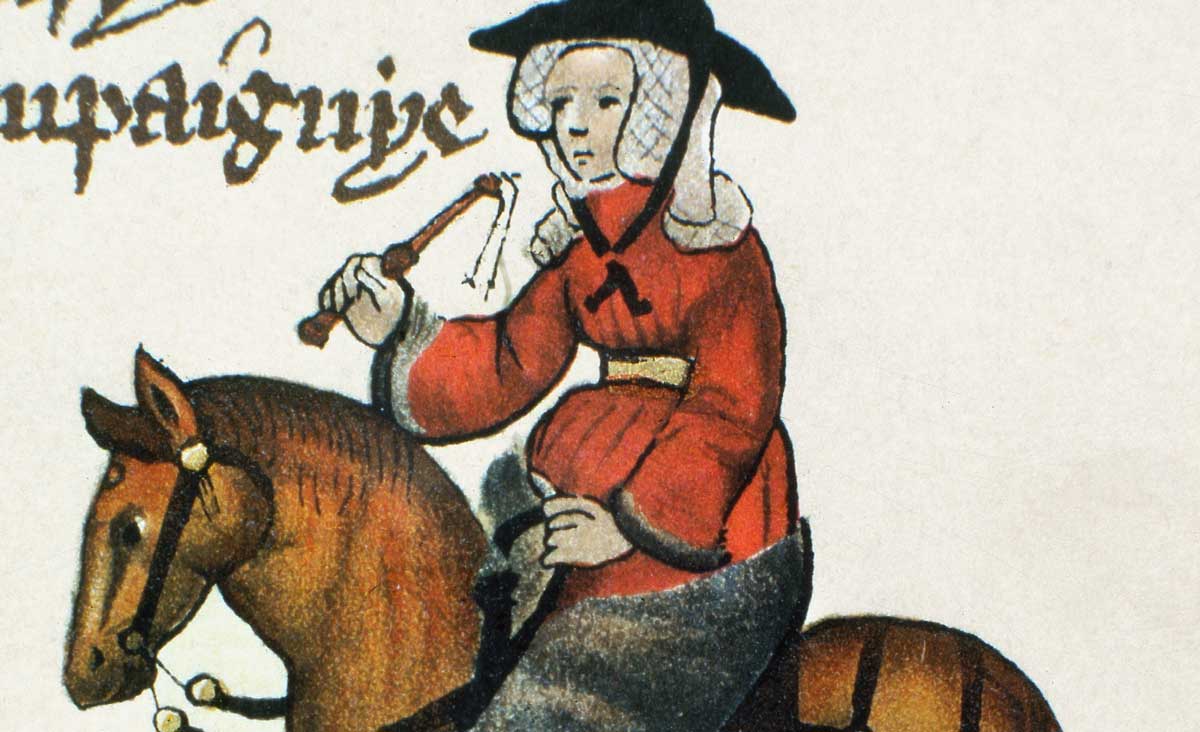Are you Experienced? | History Today - 5 minutes read

Gap-toothed and garrulous, the Wife of Bath is probably the most memorable of the pilgrims in Chaucer’s Canterbury Tales. As Marion Turner shows in this ‘biography’ of the Wife, she is also the one who has attracted the most intense responses: even her fellow pilgrims seem simultaneously fascinated and appalled by her. Later readers haven’t been able to leave her alone. Whether celebrated as a proto-feminist for championing women’s right to speak about their experiences, or censured for her frankness in talking about her sex life, she always gets a reaction.
Turner argues that the Wife – Alison is her given name – is ‘the first ordinary woman in English literature’. Not a queen or a saint, witch or idealised lady-love, she is a much-married working woman and an enthusiastic traveller. She tells her tale like the other pilgrims, but it’s the story she recounts of her own life which makes her so unforgettable, as she freely discusses the pleasures and pains of her five marriages.
Though she has become a byword for bawdy humour, the Wife’s confessional speech is also a way for Chaucer to probe serious issues of literary authority and interpretation. Alison has an argument to make, an exploration of what happens when experience runs up against dogma. She disputes medieval clerics’ cynical, stereotyped views on women and marriage, because she has suffered from them: one of her husbands, whose favourite book is all about the wickedness of women, comes to blows with her over his reading in a fight which leaves her partially deaf. Alison’s life has taught her how authoritative texts can be misinterpreted for violent ends. She argues vigorously against the stereotypes that have harmed her, but most of all advocates for the right to tell her own story.
Building on the Wife’s fictional autobiography, Turner’s lively biography of Alison is divided into two halves. The first places Alison’s life in the context of stories of real medieval women: the prosperous widows, female business-owners and well-travelled pilgrims who would have been her contemporaries. Alison has been to Rome, Jerusalem, Cologne and Santiago de Compostela, so the journey from Southwark to Canterbury is nothing to her, and she is not the only medieval woman who undertook such journeys. Nor is she unusual, Turner shows, in having a skilled trade: she is a clothworker, like other enterprising working women of the late 14th century for whom opportunities opened up after the Black Death.
Much of her wealth, however, has come to her through marriage, and Turner writes engagingly about the economic and social power wielded by widows in late medieval England. Alison has had five husbands (and is on the lookout for a sixth), which sounds like comic exaggeration, but isn’t; in an era when a woman might have been married and widowed by her early teens, multiple periods of widowhood were not uncommon. Such widows had wealth and independence that made them a force to be reckoned with. One fascinating example is the Wife’s near-namesake Alice Chaucer, the poet’s granddaughter. Already a widow before she was 12, Alice went on to outlive two more husbands, taking a step upwards in status and wealth with every marriage. She ended up as Duchess of Suffolk, and as a powerful widow she administered huge estates and manoeuvred her family’s interests through the Wars of the Roses, at one point even standing trial for treason. Chaucer, and the Wife, would have been proud.
In the second half of the book, Turner surveys the reception of the Wife from the 15th century to the present day. Later ages have sometimes been more uncomfortable with her outspokenness than Chaucer and his contemporaries. What was playful fun in the 14th century might horrify 18th-century readers. Alison’s frank delight in her own sexuality was much too honest for adaptors such as Alexander Pope, who chose to heavily censor her forthright reminiscences. But many other readers have found both enjoyment and inspiration in Alison’s distinctive voice. Turner traces her influence in Shakespeare’s Falstaff and in the Wife’s kindred spirits, the Merry Wives of Windsor, hears echoes of her speech in James Joyce’s Molly Bloom, and surveys many different modern reimaginings of the character, ending with Zadie Smith’s 2021 play ‘The Wife of Willesden’.
The Wife’s story – and its enthusiastic or hostile receptions – raises issues about the treatment of women’s voices, especially the way in which older women’s experiences are belittled and dismissed. ‘Experience’ (the first word of Alison’s Prologue) is key to her importance as a character: her boldly articulated belief is that it’s her experience, not status or education, which gives her the right to talk about what affects her most. Loved or despised, her voice is impossible to ignore.
The Wife of Bath: A Biography
Marion Turner
Princeton University Press 336pp £20
Buy from bookshop.org (affiliate link)
Eleanor Parker is a columnist for History Today.
Source: History Today Feed